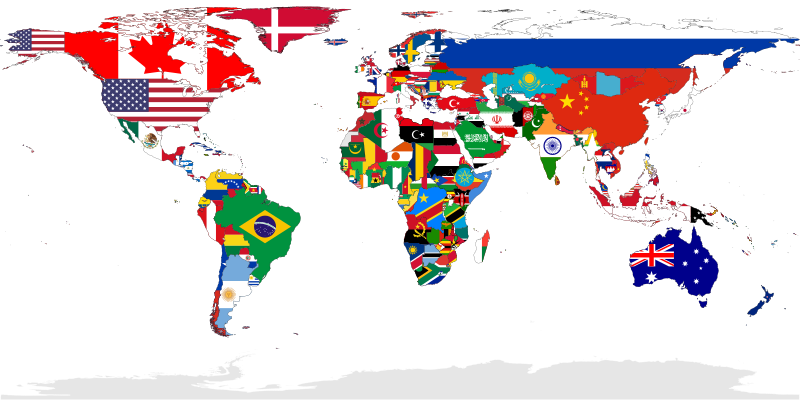How Were Countries Formed and When?

Countries formed in different ways and at different times throughout history. Some of the most common ways that countries have formed include:
- Colonization: A country colonizes another territory, and the colony eventually becomes independent.
- Unification: Two or more countries unify to form a new country.
- Secession: A region of a country secedes from the country and forms its own new country.
- Revolution: A revolution overthrows the government of a country, and the new government forms a new country.
The first countries formed thousands of years ago in Mesopotamia, Egypt, and the Indus Valley. These early countries were city-states, which were ruled by a king or other ruler from a single city.
Over time, countries became larger and more complex. Empires emerged, such as the Roman Empire and the Mongol Empire. Empires were ruled by emperors and controlled large territories.
In the Middle Ages, the feudal system developed in Europe. Under the feudal system, land was granted to nobles in exchange for their loyalty and military service. The nobles ruled their own lands and had their own armies.
In the 15th and 16th centuries, the Age of Exploration began. European explorers traveled to new lands all over the world. Many of these explorers colonized new lands for their countries.
In the 18th and 19th centuries, the Industrial Revolution transformed Europe and North America. The Industrial Revolution led to the growth of cities and the rise of the factory system. It also led to the growth of nationalism, which is the belief that one’s own country is superior to other countries.
Nationalism led to the unification of many countries in Europe and North America in the 19th century. For example, Italy and Germany were both unified in the 1860s.
In the 20th century, many colonies in Africa and Asia gained their independence. This was known as the decolonization movement. Many of these new countries were formed based on ethnic or religious groups.
Today, there are over 190 countries in the world. Each country has its own unique history, culture, and government.
Here is a timeline of some key events in the history of country formation:
- 3500 BCE: The first city-states form in Mesopotamia.
- 3000 BCE: The first unified kingdom in Egypt is formed.
- 2500 BCE: The Indus Valley Civilization emerges.
- 500 BCE: The Roman Empire begins.
- 1206 CE: The Mongol Empire begins.
- 1492: Christopher Columbus sails to the Americas, beginning the Age of Exploration.
- 1776: The United States of America declares independence from Great Britain.
- 1789: The French Revolution begins.
- 1861-1865: The American Civil War is fought.
- 1861-1870: Italy and Germany are unified.
- 1900-1945: World Wars I and II are fought.
- 1945-1960: Decolonization movement in Africa and Asia.
Colonization: A country colonizes another territory, and the colony eventually becomes independent.

Colonization is a process whereby one country establishes control over another territory, often for economic or political gain. The colony may eventually become independent, but this is not always the case.
There are many examples of colonization throughout history. Some of the most notable examples include:
- The colonization of the Americas by European powers in the 15th and 16th centuries.
- The colonization of Africa by European powers in the 19th and 20th centuries.
- The colonization of India by the United Kingdom in the 18th and 19th centuries.
- The colonization of Indonesia by the Netherlands in the 17th century.
- The colonization of the Philippines by Spain in the 16th century.
Colonization has had a profound impact on the development of the world, both positive and negative. On the positive side, colonization has led to the spread of education, healthcare, and infrastructure to many parts of the world. It has also led to the exchange of cultures and ideas.
On the negative side, colonization has also led to violence, oppression, and exploitation. Colonizers often displaced or enslaved the indigenous people of the colonized territory. They also imposed their own language, culture, and religion on the colonized people.
The legacy of colonialism continues to be felt in many parts of the world today. For example, many former colonies are still struggling to overcome the economic and political inequality that was created by colonization.
Unification: Two or more countries unite to form a new country.

Unification is the process of two or more countries uniting to form a new country. This process can be voluntary or involuntary, and it can be driven by a variety of factors, such as economic, political, or cultural.
Here are some examples of unification throughout history:
- The unification of Italy in the 19th century, which was driven by a desire for national unity and independence from foreign powers.
- The unification of Germany in the 19th century, which was driven by a desire for national unity and economic development.
- The unification of Vietnam in 1976, which was achieved through the North Vietnamese victory in the Vietnam War.
- The unification of Yemen in 1990, which was achieved through the merger of North Yemen and South Yemen.
- The unification of East and West Germany in 1990, which was achieved after the fall of the Berlin Wall and the end of the Cold War.
Unification can have a number of benefits for countries, including:
- Increased economic efficiency and growth
- Greater political stability and security
- Increased cultural and social cohesion
- A stronger international voice
However, unification can also have some challenges, such as:
- Integrating different economic systems and governments
- Addressing regional disparities and inequalities
- Promoting national unity and identity
- Managing the expectations of different groups
Overall, unification is a complex process with both potential benefits and challenges. It is important to carefully consider all of the factors involved before embarking on a unification process.
Secession: A region of a country secedes from the country and forms its own new country.

Image Credit
Secession is the act of a region withdrawing from its country and forming its own new country. It is a complex process with both historical and contemporary examples.
Some of the most notable examples of secession throughout history include:
- The American Revolution in the 18th century, when the thirteen British colonies in North America seceded from Great Britain to form the United States of America.
- The Texas Revolution in the 19th century, when Texas seceded from Mexico to form its own independent country.
- The Confederate States of America seceded from the United States in the 19th century, leading to the American Civil War.
- The Soviet Union dissolved in the early 1990s, with fifteen of its republics seceding to form independent countries.
- South Sudan seceded from Sudan in 2011, becoming the world’s newest country.
Secession can be motivated by a variety of factors, including:
- Political and economic grievances
- Cultural and religious differences
- A desire for self-determination
- A perceived threat to the region’s identity or interests
Secession can have a number of consequences, both positive and negative. On the positive side, it can lead to greater autonomy and self-determination for the seceding region. It can also lead to economic development and prosperity.
On the negative side, secession can lead to conflict and instability. It can also disrupt trade and economic ties. Additionally, secession can create a precedent for other regions to secede, which can lead to the fragmentation of a country.
Overall, secession is a complex process with both potential benefits and challenges. It is important to carefully consider all of the factors involved before embarking on a secession process.
Revolution: A revolution overthrows the government of a country, and the new government forms a new country.

Image credit
Revolution is the process of overthrowing a government and replacing it with a new one. It is often a violent and chaotic process, but it can also lead to positive change.
Some of the most notable examples of revolutions throughout history include:
- The French Revolution in the 18th century, which overthrew the French monarchy and established a republic.
- The American Revolution in the 18th century, which overthrew British rule and established the United States of America.
- The Russian Revolution in the early 20th century, which overthrew the Tsarist government and established the Soviet Union.
- The Chinese Revolution in the mid-20th century, which overthrew the Kuomintang government and established the People’s Republic of China.
- The Cuban Revolution in the late 1950s, which overthrew the Batista government and established a communist state.
Revolutions can be motivated by a variety of factors, including:
- Political and economic inequality
- Oppression and injustice
- A desire for change and progress
- A perceived threat to the country’s identity or interests
Revolutions can have a number of consequences, both positive and negative. On the positive side, they can lead to greater democracy and freedom. They can also lead to economic and social reforms.
On the negative side, revolutions can lead to violence and instability. They can also disrupt trade and economic ties. Additionally, revolutions can create a precedent for other revolutions, which can lead to political instability.
Overall, revolution is a complex process with both potential benefits and challenges. It is important to carefully consider all of the factors involved before embarking on a revolution.














